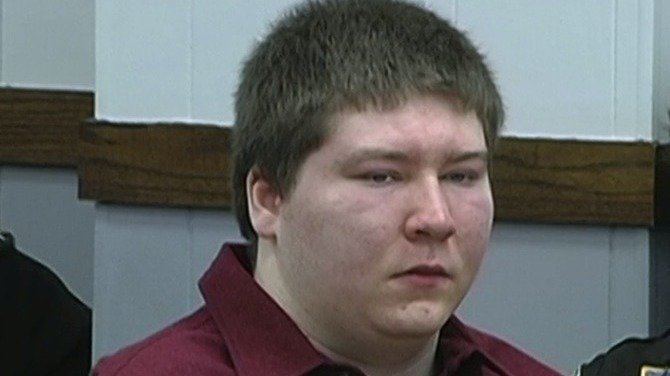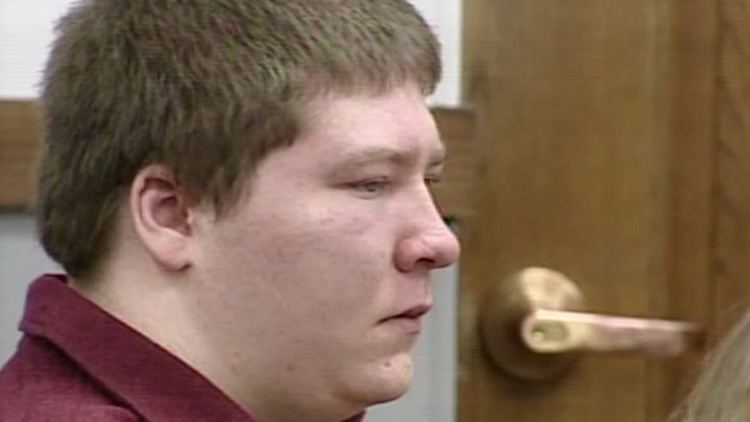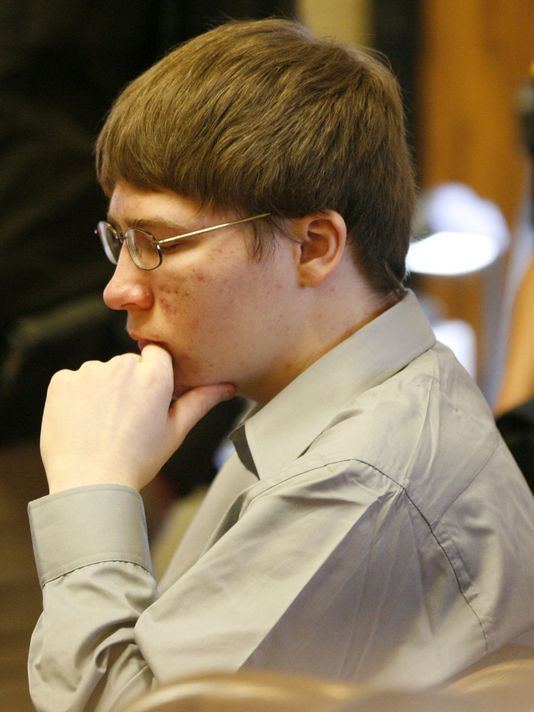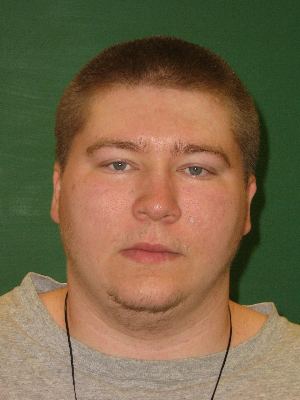Parents Barb Tadych, Peter Dassey | ||
 | ||
Full Name Brendan Ray Dassey Criminal status Incarcerated at Columbia Correctional Institution Conviction(s) First degree murderSecond degree sexual assaultMutilation of a corpse Siblings Blaine Dassey, Brad Dassey, Bobby Dassey, Bryan Dassey Similar Steven Avery, Ken Kratz, Kathleen Zellner, Moira Demos, Laura Ricciardi | ||
Making a murderer brendan dassey s conviction overturned
Brendan Ray Dassey (born October 19, 1989) is an American man from Manitowoc County, Wisconsin who was convicted of being party at age 16 to first-degree murder, mutilation of a corpse, and second-degree sexual assault, and sentenced to mandatory life in prison with a possibility of parole set for November 1, 2048. His videotaped interrogation and confession, which he recanted at trial, substantially contributed to his conviction. Parts were shown in the Netflix documentary series Making a Murderer (2015). The series examined the 2005-2007 investigation, prosecution and trials of Dassey and his uncle, Steven Avery, who were both convicted of murdering photographer Teresa Halbach on October 31, 2005.
Contents
- Making a murderer brendan dassey s conviction overturned
- Brendan dassey a true story of a false confession
- Early life
- Murder of Teresa Halbach
- Interrogation
- Reid technique
- Trial
- Appeals
- Public response
- References

Dassey's conviction was overturned on August 12, 2016, by US Magistrate Judge William E. Duffin in Milwaukee, Wisconsin, on the basis that his confession was involuntary and unconstitutionally coerced. He was ordered to be released within 90 days unless the state decides to retry him. On November 14, 2016, Duffin ordered him released, though the state's Attorney General announced plans to file an immediate emergency appeal. On November 17, 2016, the U.S. Court of Appeals for the Seventh Circuit blocked Dassey's release pending resolution of the appeal.
Brendan dassey a true story of a false confession
Early life

Brendan Ray Dassey was born to Barbara and Peter Dassey in Manitowoc County, Wisconsin. He has three brothers: Bryan, Bobby, and Blaine, and a half-brother, Brad. His parents had divorced, and Brendan lived with his mother and brothers on a large family property associated with her parents' Avery Salvage Yard. His maternal grandparents and uncles, including Steven Avery, also resided on the property.

At the time of his indictment, Dassey was a 16-year-old sophomore at Mishicot High School. With an IQ in the borderline deficiency range, he was enrolled in special education classes.

Dassey was described as a quiet, introverted young man with an interest in Wrestlemania, animals, and video games. Before this case, he had had no involvement with the criminal justice system.
Murder of Teresa Halbach

Photographer Teresa Halbach, born March 22, 1980, in Kaukauna, Wisconsin, was reported missing by her parents on November 3, 2005. Halbach, who had not been seen since October 31, resided next door to her parents in Calumet County. Halbach was known to have visited the Avery Salvage Yard in Manitowoc County on October 31, 2005.
On November 10, 2005, following the discovery of her Toyota RAV4 vehicle, Calumet County Sheriff Jerry Pagel found the charred remains of Halbach on the Avery property. Her cell phone, license plates and car key were also recovered. On November 15, after Avery's blood was found in her vehicle, Avery was charged with the kidnapping and murder of Halbach, mutilation of a corpse, and illegal possession of a firearm.
During the investigation, Dassey, Avery's alibi, underwent a series of interrogations without counsel or parent present, in which investigators made false promises to Dassey. While being interrogated, Dassey confessed in detail to being a co-conspirator in the rape and murder of Halbach and the mutilation of her corpse. His confession was later described as "clearly involuntary in a constitutional sense" by a US magistrate judge.
He was arrested and charged on March 3, 2006, with being party to a first-degree homicide, sexual assault, and mutilation of a corpse. The special prosecutor Ken Kratz held a major press conference about the two cases, discussing the charges against Avery and Dassey, and reading verbatim elements of Dassey's confession. It was widely covered by TV and newspapers.
Dassey later recanted his confession in a letter to the trial judge. He said he got most of his ideas from a book.
Interrogation
Dassey was interrogated on four occasions over a 48-hour period, including three times in a 24-hour time frame with no legal representative, parent, or other adult present. Initially interviewed on November 6 at the family cabin in Crivitz, Dassey was interrogated via the Reid technique.
Dassey recanted his confession and informed his defense counsel. He later charged that his first defense counsel collaborated with the prosecution to get Dassey to plead guilty in order to testify against Avery (which he never did.) The defense counsel was replaced. The Netflix series Making a Murderer (2015), which chronicles the trials of Dassey and Avery, has generated global dialogue centered around wrongful convictions, coerced confessions, interrogation of minors, and criminal justice reform.
Dassey's constitutional right to a competent legal defense formed the basis of his petition for a writ of habeas corpus that was filed in December 2015 in the United States District Court for the Eastern District of Wisconsin. Written by appeals counsel Laura Nirider, it said:
Petitioner Brendan Dassey is in custody pursuant to a state-court judgment of conviction. His conviction, sentence, and confinement are unlawful and were unconstitutionally obtained in violation of his Fifth, Sixth, and Fourteenth Amendment rights. In particular, this federal habeas petition asserts two claims. The first claim asserts that Brendan Dassey’s Sixth Amendment right to the effective assistance of counsel was violated when his pre-trial attorney breached his duty of loyalty by working with the prosecution to secure Brendan’s conviction. The second claim asserts that Brendan’s Fifth and Fourteenth Amendment rights to due process were violated by the admission of his involuntary confession.
A federal magistrate judge of the district court ruled in August 2016 that the interrogation resulted in an involuntary confession and violated Dassey's constitutional rights. The judge overturned Dassey's conviction and ordered him to be released within ninety days unless the state decides to retry his case.
Reid technique
Developed to permit and encourage law enforcement officers to use tactics that pressure suspects to confess, the Reid technique isolates individuals from family in small interrogation rooms where they are repeatedly accused of committing a crime. According to Tom Geraghty (Trustee of the National Institute of Trial Advocacy), when the technique is used against vulnerable suspects whose youth and cognitive disabilities make them an easy target, it will result in a false confession. Dassey had been clinically evaluated as being highly suggestible, which makes a suspect more compliant and ultimately leads to improper interrogation outcomes.
Trial
Dassey's first appointed lawyer was removed by the court on August 26, 2006, due to his decision not to appear with Brendan during the 13 May interrogation. He was replaced by two public defenders.
The Dassey trial began on April 16, 2007, with a jury from Dane County, Wisconsin. The trial lasted nine days, with a verdict delivered on April 25, 2007.
The jury deliberated for four hours, finding Dassey guilty of first-degree intentional homicide, rape and mutilation of a corpse. Dassey was tried and sentenced as an adult; his age and intellectual limitations were not a factor in this process. Dassey, at the age of 17 years and 6 months, was sentenced to life in prison with eligibility for parole in 2048. Dassey was incarcerated at the Columbia Correctional Institution in Portage, Wisconsin.
Appeals
On January 15, 2010, Dassey's post-conviction motion was brought with appellate representation by Steven Drizin, Laura Nirider, and Robert Dvorak who moved for a retrial. This motion was denied in December 2010 by Judge Fox; a decision that was later upheld by the Wisconsin Court of Appeals in January 2013. The Wisconsin Supreme Court denied Dassey's request to review his case.
In December 2015, Dassey's defense attorneys filed a writ of habeas corpus in federal district court for release or retrial, citing constitutional rights violations due to ineffective assistance of counsel and the coerced confession. In August 2016, Dassey's conviction was overturned by federal magistrate William E. Duffin, ruling that his confession was involuntary. Without the use of that confession, it is unlikely that there is sufficient evidence to retry him. Duffin granted a defense petition for Dassey's release on November 14, but an appeals court overturned his ruling on November 17, ordering that he remain incarcerated pending resolution of an appeal of the habeas decision.
Public response
The release of Making a Murderer in December 2015 generated a wide, international audience and was met with significant media attention. There were numerous discussions regarding the prosecution of criminal cases. Due to the unprecedented response to the Netflix docu-series, by July 2016 Making a Murderer 2 was in production, focusing on the post-conviction process for Dassey and his family. His conviction has been appealed through the state court system and a petition for habeas corpus was filed in federal court. Because of the nature of Dassey's interrogations, there have been calls for the exoneration of Dassey with petitions for his freedom and the implementation of the "Juvenile Interrogation Protection Law in Wisconsin", which would prohibit police from questioning minors without a lawyer present.
The United States Supreme Court describes a custodial interrogation as an interrogation where: "a reasonable person would have felt he or she was not at liberty to terminate the interrogation and leave." Even if a minor has the legal right to get up and walk out, the vast majority of minors would have no idea that they had that option. Therefore, it is reasonable to view any interrogation of a minor as a custodial interrogation. For these reasons the, "Juvenile Interrogation Protection Law in Wisconsin" should impose the following safeguards: Require that an attorney be present during any custodial interrogation of a minor. This should be viewed as a nonwaivable right. Require law enforcement to inform a minor before an interrogation begins that he or she could be charged as an adult based on information obtained during an interrogation. Wisconsin law currently falls short, as it only requires law enforcement to immediately attempt to notify the child’s parent or guardian.
In December 2015, petitions were submitted for the investigation of the police officers who interrogated Dassey, and January 2016, on the federal government's We The People website. Rallies in support of the exoneration of Dassey were held in the United States, London Manchester, Melbourne, Sydney and Perth. Supporters have been communicating with him via letters, and contributing to his prison commissary.
